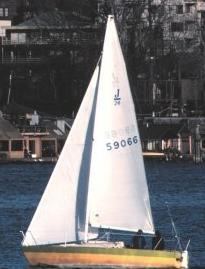 | ||
A fractional rig on a sailing vessel consists of a foresail, such as a jib or genoa sail, that does not reach all the way to the top of the mast.
Contents
In the adjacent picture, the forestay that secures the mast at the front of the boat is attached to the mast at a lower point and the fore sail (jib or genoa) is rigged to this stay. The mast is farther forward on the boat than on a masthead rig and so it has a larger main sail. Masthead rigs are most common on larger keel boats or cruisers.
A fractional rig is typically used on dinghy sailing boats and racing oriented keel boats, such as the J/24.
Fractional rigs were introduced on race boats in order to allow more controllability of the surface of the main sail and also less drag during tacking. According to one manufacturer, "a key to making fast boats easier to sail than slow boats is the fractional rig".
Usually a fractional rig features a larger main sail and a smaller non-overlapping jib. This configuration is optimized for up-wind sailing efficiency. For downwind sailing, a larger jib is more desirable but in the case of many high-performance fractional rig sailboats, the smaller jib is substituted by a spinnaker or gennaker. On many modern skiffs and race dinghies, the jib is relatively small compared to the size of the main and it is normally left in place when the spinnaker or gennaker is used due to this type of jib's minimal aerodynamic interference.
A major advantage of the fractional rig, especially the '3/4' rig (where the fore stay goes 3/4 the way up the mast), is that the jib can be taken in without the boat rounding up into the wind like a weather vane. With the masthead sloop, both the main and the jib must be reefed, when shortening sail, to keep this from happening.
Since jibs need considerable fore stay tension to set properly and the amount of tension needed increases with wind speed, being able to drop the jib first in windy conditions puts less strain on the rig and hull. Fractional rigs are used on lightly built multi-hulls for this reason.
History
Throughout the 20th century, most sloops of less than 20 feet in length have had fractional rigs.
Many (perhaps most) sailing sloops from the first part of the 20th century were fractional rigged. The increased prevalence of fractional rigs on sloops in the early 20th century probably coincided roughly with the disappearance of the gaff rig. One possibility for its increased prevalence during this era is that, relative to a masthead rig, it allows the designer to provide the boat with more sail area without using a bowsprit or a boom that extends beyond the stern, and without demanding that the sails be of a very high aspect ratio. This was important because the sailcloth available in those days made it difficult to construct high-aspect sails.
As sailcloth improved in the second half of the 20th century, it became possible to construct sails of a higher aspect ratio. It therefore became more practical for sloops to be designed with the simpler masthead-rigged mast. Most production sailboats from the '60s and '70s were masthead-rigged sloops. Masthead-rigged sloops typically carry a larger spinnaker than fractional-rigged sloops, and therefore enjoy a speed advantage when racing downwind.
Fractional rigged sloops are starting to become popular again, especially for high-performance racing boats. A fractional rig allows the mast to bend more easily, which in turn allows more adjustment to the shape of the mainsail, especially when sailing upwind. Many people believe that a fractional-rigged sloop is faster upwind than a similar masthead-rigged sloop, especially as the wind strength increases. Most of the newest generation of fractional-rigged sloops fly their spinnakers from the top of the mast. These boats are said to have "masthead spinnakers", and this development gives the boat very good performance both upwind and downwind in all wind strengths.
Maintaining forestay tension
An inherent problem of a fractional rig is its inability to exert as much tension on the forestay as a similar masthead rig. The reason for this is because the attachment point of the forestay is not directly opposite to the backstay. Under certain conditions, the moment arm that results from these offset attachment points can be used to advantage, as this is an effective method of inducing bend in the mast, which in turn flattens the mainsail. If the distance between the attachment points is too great, a mast of average stiffness will be unable to apply optimum forestay tension, unless one of the following mast-stiffening design features is used:
